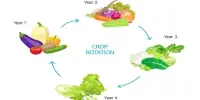Scientists have discovered previously unknown ways for agricultural diseases to get through plant cell walls, paving the door for the development of effective disease management technology. Bacterial infections in plants are notoriously difficult to eradicate. The focus is on stopping the bacterium from spreading rather than treating the plant. The latest study, which was published in Science, identifies a family of enzymes discovered in the Phytophthora infestans bacterium.
Crop infections can use the enzymes to break down pectin, a crucial component of plant cell walls, allowing them to get past the plant’s defenses and infect it. The multinational team of researchers, lead by biologists and chemists from the University of York, identified a new class of pectin-attacking enzymes known as LPMOs. The researchers also demonstrated that blocking the gene that encodes this enzyme prevented the virus from infecting the host.
P. infestans is known to cause potato late blight, a severe plant disease that resulted in widespread famine in Europe and over a million fatalities in Ireland during the 1840s, dubbed “The Great Famine.” Plant infection continues to devastate worldwide agricultural output to the tune of billions of dollars each year, posing a serious danger to global food security.
The discovery of this novel gene may pave the way for new strategies to protect crops against this key group of diseases. Lead author on the report, Dr Federico Sabbadin, from the Biology Department’s Centre for Novel Agricultural Products (CNAP), at the University of York said: “These new enzymes appear to be important in all plant pathogenic oomycetes, and this discovery opens the way for potentially powerful strategies in crop protection.”
Plants, like people, have an immune system that aids in the battle against illness. Plant immunity differs in several ways: they don’t produce antibodies and can’t fight the same pathogen months or years later.
Plant cells, on the other hand, can recognize pathogens and respond to them, frequently by releasing a burst of reactive oxygen that is deadly to bacteria and fungus. To seal off the illness, cells around an infected location will go into programmed cell death.
When a pathogen invades plant tissue and forms a parasitic relationship with the plant, infection occurs. Viruses, bacteria, and phytoplasmas cannot actively penetrate or enter the tissues of their plant hosts.
As a result, they must rely on alternative approaches to infect plant tissues and cells. These diseases have formed alliances with insect vectors to enhance inoculation and dispersion. Beneficial bacteria are engaged in a variety of activities, including animal digestion, nitrogen fixation in the roots of some legumes, animal and plant decomposition, and sewage disposal systems. In people, animals, and plants, pathogenic bacteria, on the other hand, cause serious and frequently deadly illnesses.
Professor Neil Bruce (CNAP) and Professors Gideon Davies and Paul Walton in the Department of Chemistry at York said the work was “the result of interdisciplinary collaborations between biologists and chemists at York, plant pathologists at the James Hutton Institute, and genomicists at CNRS, with invaluable molecular insights from Professor Neil Bruce (CNAP) and Professors Gideon Davies and Paul Walton in the Department of Chemistry at York.”
The study is part of the New Enzymatic Virulence Factors in Phytophthora infestans initiative, which will run from 2021 to 2025 and is funded by a £1 million grant from the UK Research and Innovation’s (UKRI) Biotechnology and Biological Sciences Research Council.
















